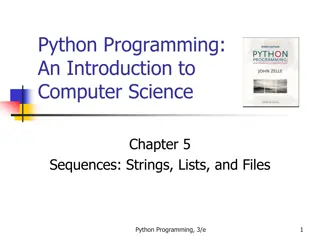Understanding Python Lists: Basics and Operations
Python lists are versatile data structures that allow for storing different types of items and modifying them easily. This introduction covers topics like list creation, indexing, modification, slicing, and more, providing a solid foundation for working with lists in Python.
Download Presentation

Please find below an Image/Link to download the presentation.
The content on the website is provided AS IS for your information and personal use only. It may not be sold, licensed, or shared on other websites without obtaining consent from the author. Download presentation by click this link. If you encounter any issues during the download, it is possible that the publisher has removed the file from their server.
E N D
Presentation Transcript
Introduction to Python Lists 1
Topics 1) Lists 2) List indexing 3) Traversing and modifying a list 4) Summing a list 5) Maximum/Minimum of a list 6) List Methods 2
Containers Python includes several built-in sequences: lists, tuples, strings. We will discuss these in the next few lectures. Here's a broad overview: Lists and tuples are container sequences, which can hold items of different type. String is a flat sequence which holds item of one type(characters). Another way of grouping sequence types is by mutability. Lists are mutable(can be modified) sequences while strings and tuples are immutable sequences. We discuss lists in this lecture. 3
Lists Lists are the basic ordered and mutable data collection type in Python. They can be defined with comma-separated values between square brackets. L = [2, 3, 5, 7] print(len(L)) L.append(11) print(L) # 4, len() also works with strings # append to the end of the list # [2, 3, 5, 7, 11] 4
Indexing Indexing is a means the fetching of a single value from the list. This is a 0-based indexing scheme. L = [2, 3, 5, 7, 11] print(L[0]) print(L[1]) print(L[5]) # 2 # 3 # index out of bounds error. 5
Lists can contain different types of objects List can contain different types and even other lists. L = [1, 'two', 3.14, [-2, 3, 5]] print(L[0]) print(L[1]) print(L[3]) print(L[3][0]) # -2 print(L[3][1]) # 3 print(L[3][2]) # 5 # 1 # two # [-2, 3, 5] 6
Modifying a List Indexing can be used to set elements as well as access them. L = [2, 3, 5, 7, 11] L[0] = 100 print(L) L[2] = -4 print(L) # [100, 3, 5, 7, 11] # [100, 3, -4, 7, 11] 7
Slicing(same as for Strings) We saw in the previous lecture that we can slice a string by specifying a start-index and stop-index, and the result is a subsequence of the items contained within the slice. Slicing also works with lists!(As well as many important data structures in Python) Slicing can be done using the syntax: my_list[start:stop:step] where start: index of beginning of the slice(included), default is 0 stop: index of the end of the slice(excluded), default is length of the list step: increment size at each step, default is 1.
List Slicing L = [10, -2, 1, 6, 2] print(L[1:3]) print(L[:3]) print(L[1:]) print(L[0:4:2]) print(L[:]) print(L[::-1]) # [-2, 1] # [10, -2, 1] # [-2, 1, 6, 2] # [10, 1] # [10, -2, 1, 6, 2] # [2, 6, 1, -2, 10]
Traversing a list We can traverse through a list using a for loop. We have seen this before with strings! There are two options: 1) for each loop: nums = [2, -1, 3, 4, -3] for x in nums: print(x, end=" ") 2 -1 3 4 -3 Looping through each value 2) loop using indices nums = [2, -1, 3, 4, -3] for i in range(len(nums)): print(nums[i], end=" ") 2 -1 3 4 -3 Looping through each index i takes on values: 0,1,2,3,4. 10
Modifying a list Consider the following code that is intended to change all even numbers in a list to 0. nums = [24, 3, 34, 6, -5, 4] for x in nums: if x % 2 == 0: x = 0 print(nums) Output: [24, 3, 34, 6, -5, 4] Note: The list is unchanged? Why? How can we fix it? 11
Modifying a list Here's the correct code to change all even numbers in a list to 0. Compare the following code to the previous slide. nums = [24, 3, 34, 6, -5, 4] for i in range(len(nums)): if nums[i] % 2 == 0: nums[i] = 0 print(nums) Output: [0, 3, 0, 0, -5, 0] 12
Creating a list If you want to create a list containing the first five perfect squares, then you can complete these steps in three lines of code: squares = [] for i in range(5): squares.append(i ** 2) # add each square to list print(squares) # create empty list Output: [0, 1, 4, 9, 16] There is a much simpler way to create this list using list comprehensions. 13
Creating a list with list comprehensions List comprehensions is a way to create a list in Python that is concise and elegant. Its main use is to create a new list from a given list. Instead of: squares = [] # create empty list for i in range(5): squares.append(i ** 2) # add each square to list Do this: squares = [i ** 2 for i in range(5)] # one line! List comprehensions allow you to use a conditional. even_squares = [i ** 2 for i in range(5) if i % 2 == 0] print(even_squares) # [0, 4, 16] 14
Algorithms to know The following algorithms are useful. Know how to implement these algorithms! 1) Find sum of a list of numbers. 2) Find the average of a list of numbers. 3) Find the maximum/minimum of a list of numbers. 15
Sum of a list Given a list, find the sum of its elements. We can do this by traversing through the list using a for loop. nums = [2, -1, 3, 4, -3] s = 0 for x in nums: s += x print(s) Whenever we have a piece of code that accomplish a useful task, we should put it in a function. 16
Sum Function Write a function that accepts a list of numbers as a parameter and returns its sum. def sum(nums): s = 0 for x in nums: s += x return s lst = [2, -1, 3, 4, -3] print(sum(lst)) # 5 lst2 = [1, 5, 4, 2] a = sum(lst2) print(a) # 12 17
Average Function Write a function that accepts a list of numbers as a parameter and returns its average. def average(nums): s = 0 for x in nums: s += x return s/len(nums) lst = [2, 5, 4, 3] a = average(lst) print(a) # 3.5 18
Conditional Summing Write a function that accepts a list of numbers as a parameter and returns the sum of all even numbers in the list. def sum_even(nums): s = 0 for x in nums: return s if x % 2 == 0: s += x 19
Find Maximum Function Write a function that accepts a nonempty list of numbers as a parameter and returns its maximum value. Does the code below work? def maximum(nums): current_max = 0 for x in nums: return current_max Incorrect! if x > current_max: current_max = x lst = [-2, -5, -12, -3] a = maximum(lst) print(a) No! What if the list contains only negative numbers?This function returns 0 which is not even in the list! # 0 INCORRECT! 20
Find Maximum Function(Correct) Here's the correct implementation of maximum. The minimum function is similar. def maximum(nums): current_max = nums[0] for x in nums: if x > current_max: return current_max # the first value is maximum # until a bigger value shows up current_max = x lst = [2, 5, 12, 3, 4, 11] a = maximum(lst) print(a) # 12 21
List Methods The following is a short list of useful list methods. append(value) appends value to the end of the list insert(index, value) inserts value at position given by index, shifts elements to the right. removes object at index from list, shifts elements left and returns removed object. Returns last element if index is omitted. The index parameter is optional(default to last element). splits a string into a list. A separator can be specified. The default separator is any whitespace. Note that this is a string method not a list method. pop(index) split() 22
List Methods L = [3, "hi", -4, 6] L.append(2) L.insert(1, "hello") a = L.pop(3) print(a) L.pop() print(L) # L = [3,"hi",-4, 6, 2] # L = [3,"hello","hi",-4, 6, 2] # L = [3,"hello","hi",6, 2] # -4 # ok to not store popped value # [3,"hello","hi",6] 23
split() The split() method splits a string into a list. A separator can be specified. The default separator is any whitespace. fruits = "apple mango banana grape" fruits_lst = fruits.split() print(list_fruits) # [ apple , mango , banana , grape ] greeting = hi,I am Mike,I just graduate. greet_lst = greeting.split(",") print(greet_lst) # [ hi , I am Mike , I just graduate. ] nums = 4 24 12 nums_lst = nums.split() print(nums_lst) # [ 4 , 24 , 12 ], these are still strings 24
Create a list from user inputs Ask the user to enter a list of numbers of any length separated by spaces. Generate a list containing those numbers. The split() function can be used here. nums = input("Enter list of numbers separated by spaces: ").split() print(nums) Sample output: Enter list of numbers separated by spaces: 4 6 1 23 ['4', '6', '1', '23'] Note that the list above is a list of strings! We like this to be a list of integers. 25
Create a list from user inputs From the previous example, we can change each string in the list by manually casting it to an integer. nums = input().split() for i in range(len(nums)): nums[i] = int(num[i]) # cast string to integer print(nums) Sample output: 4 6 1 23 [4, 6, 1, 23] We can further simplify the code above using list comprehensions! This code below can used in many of the replit Teams problems for this lecture. nums = [int(x) for x in input().split()] 26
Lab 1 Create a new repl on repl.it 1) Create this list and assign it to a variable [3,41,62,87,101, 88]. Use a for loop to compute the sum. Print out the sum. 2) Use a for loop to compute the sum of odd numbers from the list above. 3) Use a for loop to compute the sum of values located at even indices.(Use the len() function). 31
References 1) Vanderplas, Jake, A Whirlwind Tour of Python, O reilly Media. 2) Luciano, Ramalho, Fluent Python, O'reilly Media. 32























